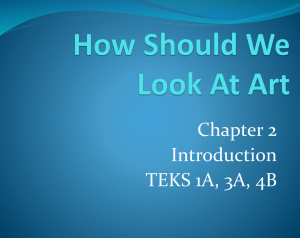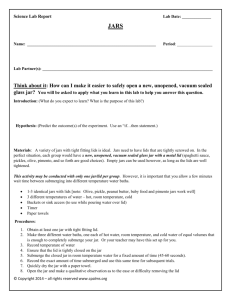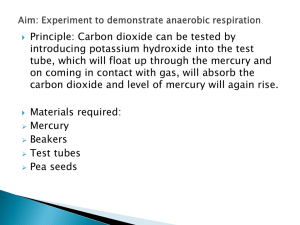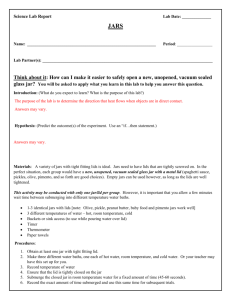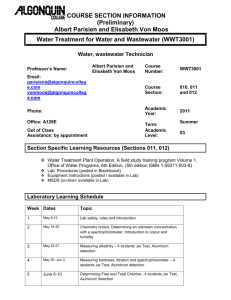13 Products of combustion
advertisement
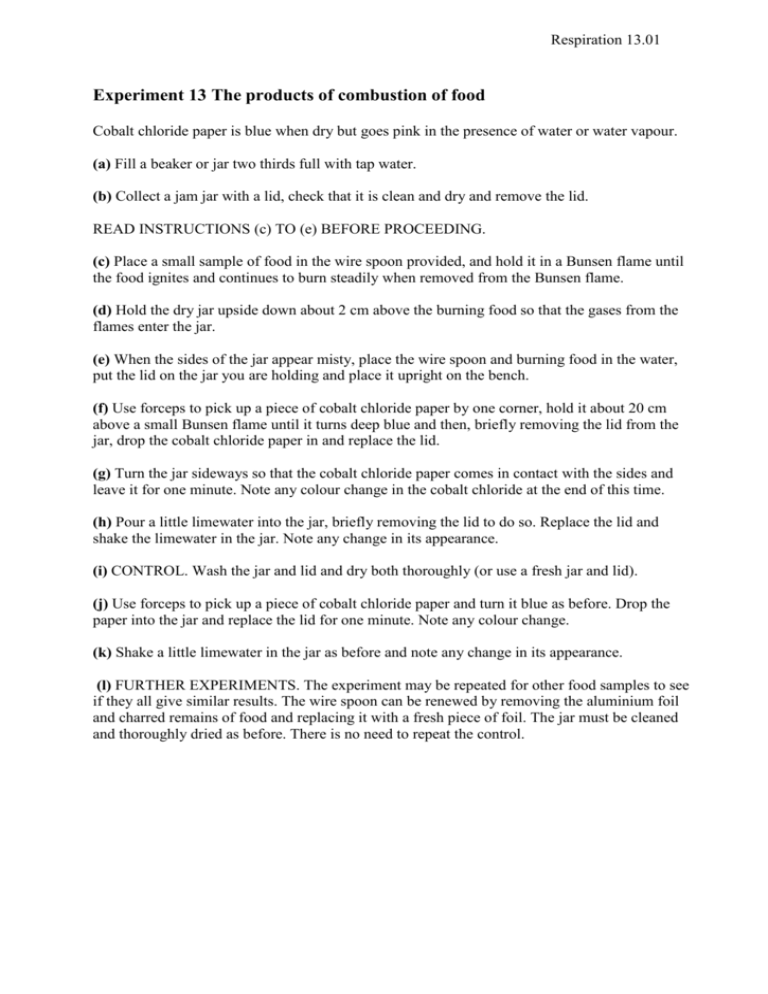
Respiration 13.01 Experiment 13 The products of combustion of food Cobalt chloride paper is blue when dry but goes pink in the presence of water or water vapour. (a) Fill a beaker or jar two thirds full with tap water. (b) Collect a jam jar with a lid, check that it is clean and dry and remove the lid. READ INSTRUCTIONS (c) TO (e) BEFORE PROCEEDING. (c) Place a small sample of food in the wire spoon provided, and hold it in a Bunsen flame until the food ignites and continues to burn steadily when removed from the Bunsen flame. (d) Hold the dry jar upside down about 2 cm above the burning food so that the gases from the flames enter the jar. (e) When the sides of the jar appear misty, place the wire spoon and burning food in the water, put the lid on the jar you are holding and place it upright on the bench. (f) Use forceps to pick up a piece of cobalt chloride paper by one corner, hold it about 20 cm above a small Bunsen flame until it turns deep blue and then, briefly removing the lid from the jar, drop the cobalt chloride paper in and replace the lid. (g) Turn the jar sideways so that the cobalt chloride paper comes in contact with the sides and leave it for one minute. Note any colour change in the cobalt chloride at the end of this time. (h) Pour a little limewater into the jar, briefly removing the lid to do so. Replace the lid and shake the limewater in the jar. Note any change in its appearance. (i) CONTROL. Wash the jar and lid and dry both thoroughly (or use a fresh jar and lid). (j) Use forceps to pick up a piece of cobalt chloride paper and turn it blue as before. Drop the paper into the jar and replace the lid for one minute. Note any colour change. (k) Shake a little limewater in the jar as before and note any change in its appearance. (l) FURTHER EXPERIMENTS. The experiment may be repeated for other food samples to see if they all give similar results. The wire spoon can be renewed by removing the aluminium foil and charred remains of food and replacing it with a fresh piece of foil. The jar must be cleaned and thoroughly dried as before. There is no need to repeat the control. Respiration 13.02 Experiment 13. Discussion 1 What gases are produced by the samples of burning food? 2 What evidence have you that these gases are produced? 3 Both these gases are already present in the atmosphere. How can you be sure that your tests relate to the gases from burning food and not those already present in the air? 4 Are these gases the only product of combustion of food? 5 What evidence is there that energy is released from the food during the experiment? 6 Assuming that all food substances contain carbon and hydrogen, explain the production of the two gases from burning food in simple chemical terms. 7 Living organisms derive their energy from food. In what ways is the burning of food (a) similar to, (b) different from, the use of food for providing energy in the body The gases from the burning food collect in the jar Respiration 13.03 Experiment 13. The products of combustion of food - preparation Outline The gases from burning food samples are collected in an inverted jam jar and tested with cobalt chloride paper and limewater. Prior knowledge Carbon dioxide turns limewater milky; water turns cobalt chloride pink. Advance preparation and materials Jars. 450g jam jars with snap-on lids are ideal, but screw-top jars, or gas jars will do. They must be clean and dry. Wire spoons. Make a loop about 15 mm in diameter at one end of a 30 cm length of galvanized (or copper) wire and form the other end into a suitable handle. Press a piece of aluminium foil about 3 cm square over the loop and hollow out to make a spoon. Cobalt chloride paper. Dissolve 1 g cobalt chloride in 20 cm3 distilled water. Pour the solution on to filter papers and allow them to dry. Cut squares of about 1 cm side. Allow two or three per group. Limewater. Shake distilled water with an excess of calcium hydroxide and allow the lime to settle. Decant off the clear liquid. Allow 100 cm3 per group and test the limewater before the experiment by bubbling exhaled air through it. Food samples. A half peanut is convenient. Dry bread, dry biscuits (cream crackers) and cheese are suitable. Oil, fat and biscuits or pastry containing fat are unsuitable because they produce large and sooty flames. Sucrose burns erratically and splashes molten sugar about. Apparatus-per group 1 jar and lid as described above. 1 wire spoon as described above 1 jar or beaker for water container for cobalt chloride papers 1 Bunsen burner container or pieces of paper for food samples. spare squares of foil for renewing spoons cobalt chloride papers Respiration 13.04 Experiment 13 Discussion - answers 1 Carbon dioxide and water vapour are produced by all the samples of burning food. 2 Limewater turning milky provides evidence of carbon dioxide. Condensation in the jar shows that a vapour is produced and the cobalt chloride paper turning pink shows that this is water vapour. 3 Atmospheric air in the control jar did not turn the cobalt chloride paper pink in one minute. Neither did it turn limewater milky. 4 Only carbon dioxide and water are detected by this experiment. There might be many other substances produced which the experiment will not reveal. There will be a residue of carbon on the spoon. 5 The heat and light given out by the burning food is evidence of the release of energy. 6 Burning involves a combination with oxygen. Carbon combines with oxygen to produce carbon dioxide; hydrogen combines with oxygen to produce water. 7 (a) Similarities are the production of heat and the substances carbon dioxide and water. (b) The differences are (i) light energy is not often released by respiration (ii) the temperature of burning food is far higher than in any living organism (iii) the burning is uncontrolled and would continue until nearly all the food is burnt; the reactions in respiration are controlled, the energy being released in stages and the reactions being regulated by enzymes (iv) the energy is transferred rather than 'released' and can be used for many changes other than the production of heat, e.g. muscle contraction and nervous conduction.

